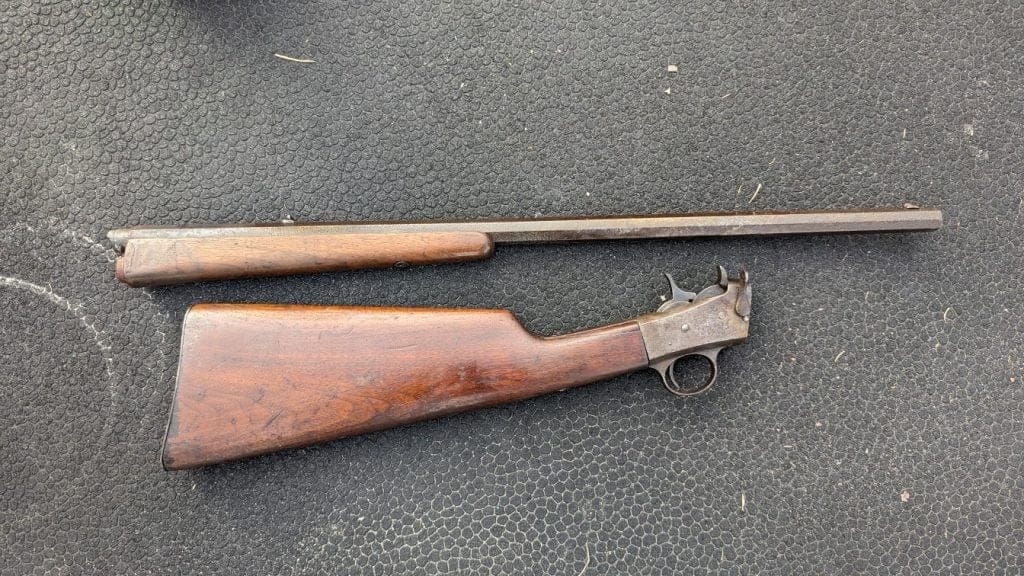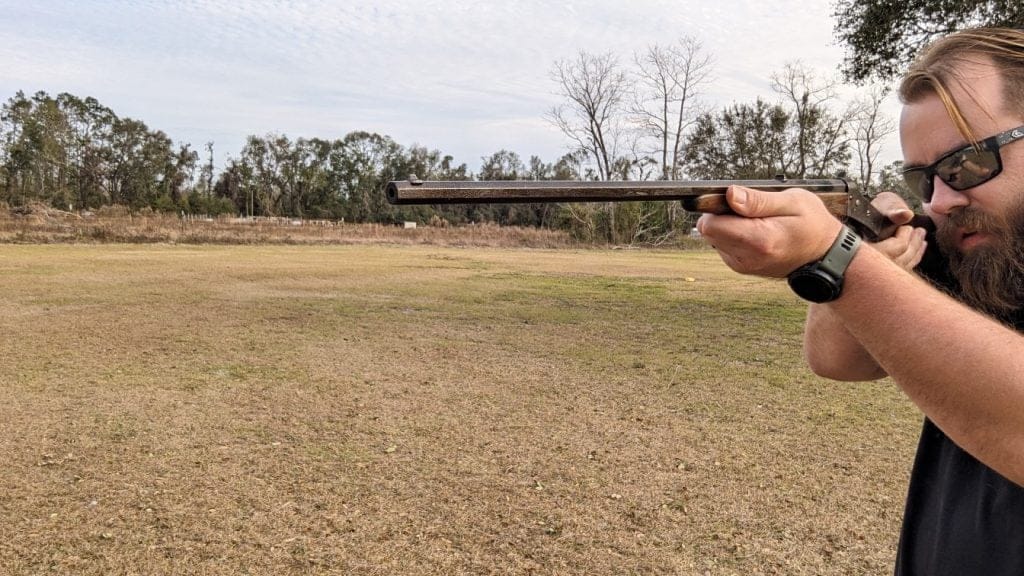I love rimfire rifles simply because they’re available in a wide variety of designs and mechanisms. Sure, semi-autos are common, but so are bolt-actions, lever-actions, and oddballs, like the Remington Model 4 Rolling Block I have in front of me. The rolling block action was designed for big bore cartridges, as well as small, rimfire cartridges like the .22 Short.

Sometimes, companies establish a ‘brand’ and go out of their way to establish a foothold in the market. For example, Winchester was first known as a lever gun company, Colt was a revolver company, and for a short while, Remington was a Rolling Block company (they didn’t invent the Rolling Block design, but they arguably perfected it).
The Remington Model 4 represented a rimfire or small-bore version of the Remington Rolling Block design.

The Remington Model 4 began production in 1890 and was produced until 1930. They came in numerous calibers, including .22 Short, .22 Long, .22 LR, .25 Stevens, .32 Short, and .32 Long. None of these calibers are known to be particularly powerful. They made the Model 4 a fun little carbine.
So fun, in fact, that the Boy Scouts had their special edition of the gun at one point. Remington also has the Model Four, which is a modern, gas-operated hunting rifle, but today, we are talking about the Model 4.
The Legendary Rolling Block
Remington didn’t invent the rolling block. The first concept came from Leonard Geiger. Geiger wanted to create a cartridge firearm that was cheap and easy to produce, which led to the Geiger split breech carbine. Remington made a few, but eventually, Remington employee Jospeh Rider took a look at the rifles and patents and began improving them.
There were several variations from the Geiger split breech to the final Rolling Block. The final Rolling Block rifles would go on to become one of the most successful single-shot rifles ever developed. The name refers to how the chamber is blocked. Cartridge rifles cannot be loaded through the barrel like a muzzleloader. Instead, they were loaded from the rear.

If the opening was left open in the rear, the force of the gas propelling the projectile down the barrel would put equal force on the cartridge, throwing it rearward. This led us to several different blocking solutions. The rolling block is named because the block rolls back and forth.
When you look at the Model 4, there appear to be two hammers. The most rearward hammer is the actual hammer, and the other hammer is the tab to roll the block rearward and forward. The user rolls the block backward and loads the chamber. Once the rifle is loaded, the user rolls the block forward, and the gun is ready to fire.
The Model 4
The Remington Model 4 in my possession is a .22 model.
Which .22? Great question.
Several models were produced, and the older models were produced in .22 Shot and Long, but long Rifles weren’t introduced until later. To be safe, I only fired .22 Short and .22 Long through the gun. For clarity, .22 Long and .22 Long Rifle are different cartridges. .22 Long can be fired in .22LR rifles, but not vice versa.
The Model 4 I have is a takedown model that was produced sometime between 1901 and 1926. I know this because my Model 4 has a takedown lever and not a takedown screw. Takedown screw models were produced after 1926. As a takedown, the barrel separates from the receiver. Spin the lever around, and it pops right off.


The barrel is a beastly octagonal design. It’s so incredibly thick for a .22 rifle. It provides the rifle with a good bit of forward weight. This weight helps stabilize the rifle in the standing position, and honestly, the octagonal barrel just looks fantastic. My variant isn’t in perfect condition, but it’s perfectly safe to fire.
These rifles are very well made. They are intended to be small game hunting rifles and very accurate shooters. They provided rolling block enthusiasts with a smaller, lighter rifle and allowed Remington to stay on brand and enter the small rifle market.
To the Range
This rifle wasn’t made as a boy’s rifle. It’s a full-length rifle that fits me a lot better than the Stevens Little Scout. The Model 4 features a classic stock with a deep curve inward. It has a straight rifle grip, no pistol grip. The straight stock makes accessing the hammer and rolling block easy and comfortable. To load the gun, you cock the hammer to the rear. Next, you roll back the block, and you have access to the chamber. Simply push a projectile in and thumb the rolling block back forward.


Believe it or not, I have a small pile of .22 Long rounds. The little .22 Short is easy to find, but .22 Long tends to be tougher. When I find some, I snag it up for reasons unknown to me until yesterday. I threw a good bit of my pile downrange to great amusement. I followed with some .22 Short just because I had a few failures to fire with the .22 Long, likely due to its age. The .22 Short rounds always fired.


I had one .22-long cartridge split in the chamber. The built-in extractor couldn’t pull it out. Luckily, as a takedown rifle, it was easy to separate the barrel from the receiver and access the chamber. A pair of Leatherman pliers pulled it right out without issue.
Plinking Like a Gentleman
The gun’s sights are small, and age hasn’t helped them. They’ve been chipped away, bent here and there. They were already small, and they’re even smaller now. I can make them out, but they aren’t going to be quick and easy to use. They are simple open sights, and hitting most soda cans isn’t tough, but fired shotgun hulls are a bit tougher to shoot.



The trigger is well-worn and absolutely fantastic. It’s super crisp, and just a slight pull sends the hammer home and the round downrange. The rifle itself shoots very consistently and quite accurately. My son and I rested the gun on a bench and bag at 25 yards, and when we got a good-sight picture, we were hitting the smallest swingers on a Know Your Limits target.


I won’t Bubba an optic to the gun, I promise, but I really want to. I bet a nice set of sights would make this one of my more accurate rimfire blasters. Remington went all out for a single-shot squirrel stalker.
Keep On Rolling
The Model 4 is the easiest and most affordable way to get into the Rolling block game. Admittedly, the .22 caliber models are going to be the easiest to source ammo for. With that said, stay away from high-velocity loads as they were never intended for this gun. Finding the various .32 rimfire rounds would be difficult, and until today, I had never heard of .25 Stevens until I bought a Model 4, so good luck.

